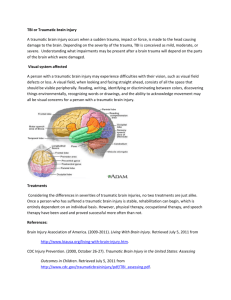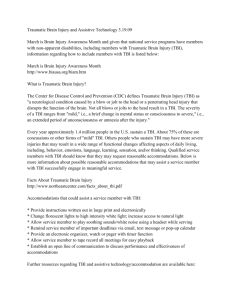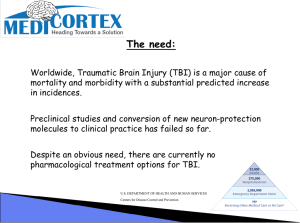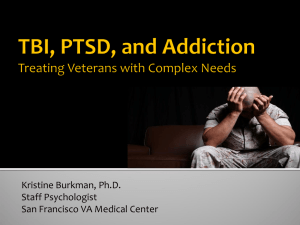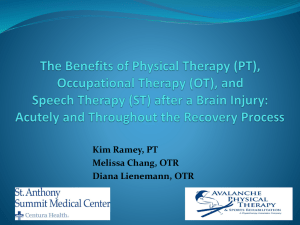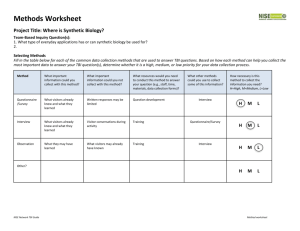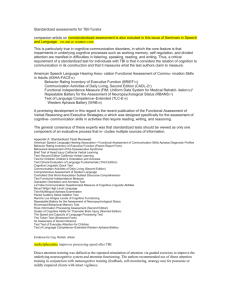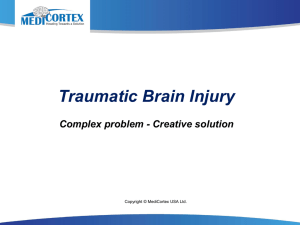Facts about Traumatic Brain Injury
advertisement
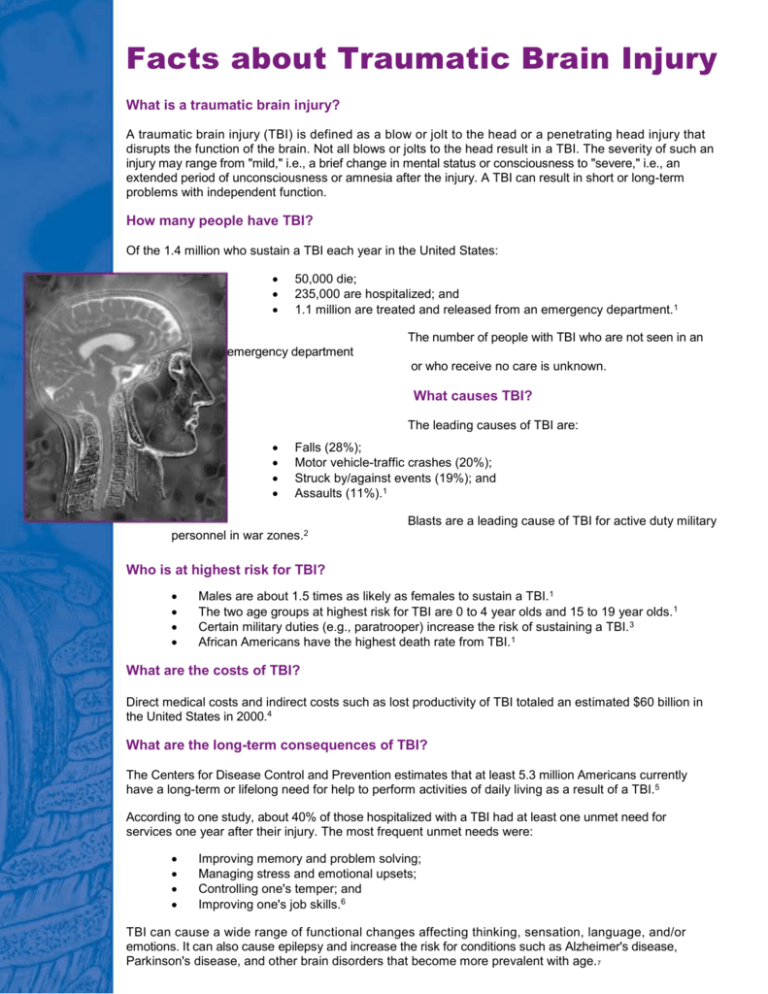
Facts about Traumatic Brain Injury What is a traumatic brain injury? A traumatic brain injury (TBI) is defined as a blow or jolt to the head or a penetrating head injury that disrupts the function of the brain. Not all blows or jolts to the head result in a TBI. The severity of such an injury may range from "mild," i.e., a brief change in mental status or consciousness to "severe," i.e., an extended period of unconsciousness or amnesia after the injury. A TBI can result in short or long-term problems with independent function. How many people have TBI? Of the 1.4 million who sustain a TBI each year in the United States: 50,000 die; 235,000 are hospitalized; and 1.1 million are treated and released from an emergency department.1 The number of people with TBI who are not seen in an emergency department or who receive no care is unknown. What causes TBI? The leading causes of TBI are: Falls (28%); Motor vehicle-traffic crashes (20%); Struck by/against events (19%); and Assaults (11%).1 Blasts are a leading cause of TBI for active duty military personnel in war zones.2 Who is at highest risk for TBI? Males are about 1.5 times as likely as females to sustain a TBI.1 The two age groups at highest risk for TBI are 0 to 4 year olds and 15 to 19 year olds. 1 Certain military duties (e.g., paratrooper) increase the risk of sustaining a TBI. 3 African Americans have the highest death rate from TBI.1 What are the costs of TBI? Direct medical costs and indirect costs such as lost productivity of TBI totaled an estimated $60 billion in the United States in 2000.4 What are the long-term consequences of TBI? The Centers for Disease Control and Prevention estimates that at least 5.3 million Americans currently have a long-term or lifelong need for help to perform activities of daily living as a result of a TBI.5 According to one study, about 40% of those hospitalized with a TBI had at least one unmet need for services one year after their injury. The most frequent unmet needs were: Improving memory and problem solving; Managing stress and emotional upsets; Controlling one's temper; and Improving one's job skills.6 TBI can cause a wide range of functional changes affecting thinking, sensation, language, and/or emotions. It can also cause epilepsy and increase the risk for conditions such as Alzheimer's disease, Parkinson's disease, and other brain disorders that become more prevalent with age. 7 Collaborating Organizations Brain Injury Association of America www.biausa.org 800-444-6443 References 1. Lang lois JA, Rutland-Brown W, Thomas KE. Traumatic brain injury in the United States: emergency department visits, hospitalizations, and deaths. Atlanta (GA): Centers for Disease Control and Prevention, National Center for Injury Prevention and Control; 2006. Centers for Disease Control and Prevention www.cdc.gov 800-311-3435 2. Defense and Veterans Brain Injury Center www.dvbic.org 800-870-9244 Defense and Veterans Brain Injury Center (DVBIC). [unpublished]. Washington (DC): U.S. Department of Defense; 2005. 3. Ivins BJ, Schwab K, Warden D, Harvey S, Hoilien M, Powell J, et al. Traumatic brain injury in U.S. army paratroopers: prevalence and character. Journal of Trauma Injury, Infection and Critical Care 2003;55(4): 61 7-21. 4. Finkelstein E, Corso P, Miller T and associates. The Incidence and Economic Burden of Injuries in the United States. New York: Oxford University Press, 2006. Health Resources and Services Administration www.hrsa.gov 301-443-3376 National Association of State Head Injury Administrators www.nashia.org 301-656-3500 National Brain Injury Research Treatment and Training Foundation www.nbirtt.org 434-220-4824 National Center for Medical Rehabilitation Research, NICHD, NIH www.nichd.nih.gov/about/ncmrr 800-370-2943 National Institute on Disability and Rehabilitation Research www.ed.gov/about/offices/list/osers/nidrr 202-245-7640 National Institute of Neurological Disorders and Stroke, NIH www.ninds.nih.gov 800-352-9424 North American Brain Injury Society www.nabis.org 703-960-6500 Social Security Administration www.ssa.gov 800-772-1213 Updated 02/06 5. Thurman D, Alverson C, Dunn K, Guerrero J, Sniezek J. Traumatic brain injury in the United States: a public health perspective. Journal of Head Trauma Rehabilitation 1999;14(6):602-15. 6. Corrigan JD, Whiteneck G, Mellick D. Perceived needs following traumatic brain injury. Journal of Head Trauma Rehabilitation 2004;19(3):205-16. 7. National Institute of Neurological Disorders and Stroke. Traumatic brain injury: hope through research. Bethesda (MD): National Institutes of Health; 2002 Feb. NIH Publication No. 02-1 58. Available from: www.ninds.nih.gov/disorders/tbi/detail_tbi.htm.
